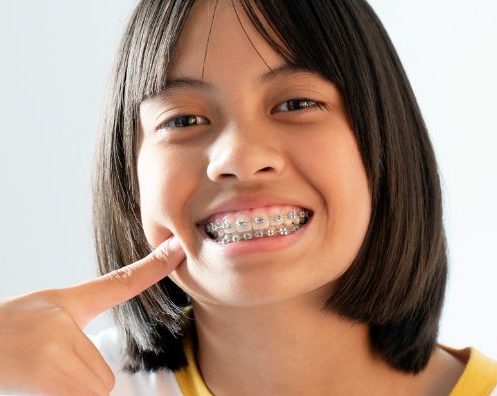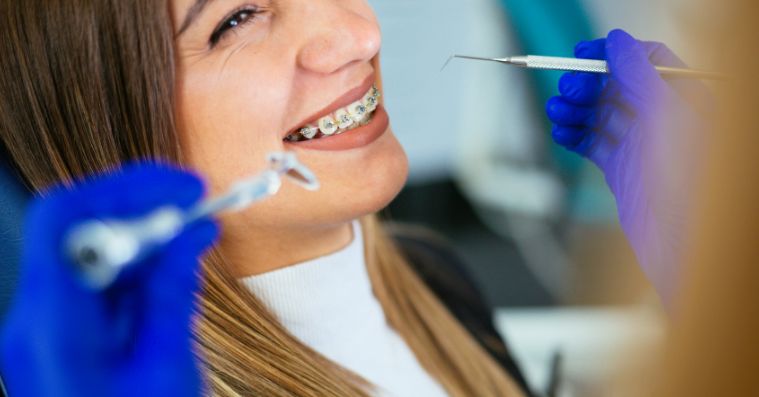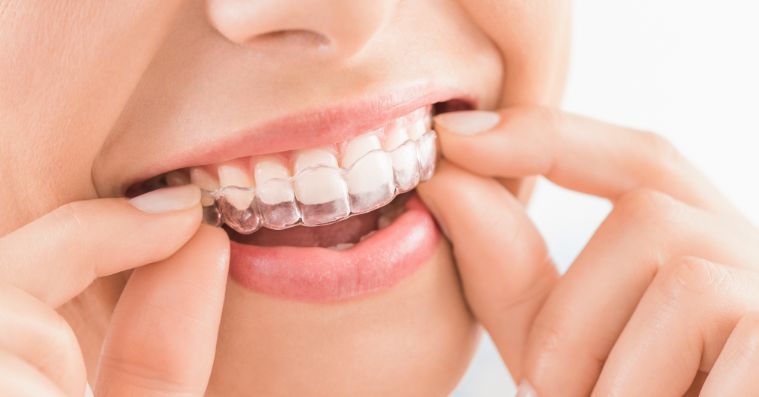Braces contribute greatly to overall dental care by correcting overcrowded teeth and addressing jaw and bite alignment, thus lowering the risk of tooth decay and cavities. However, people with braces who do not conduct proper oral hygiene can be at greater risk for cavities than people without braces. Don’t worry; the benefits of braces far outweigh this risk, especially if you follow some crucial tips to help you with daily oral care with braces.
Why Is It Easier to Get Cavities While Wearing Braces?
It can be easier to get cavities while wearing traditional metal braces, ceramic braces, and lingual braces. However, most of that risk can be reduced with proper oral care. After an orthodontist affixes braces to your teeth, the brackets can harbor bacteria and bits of food if not properly cleaned. People who do not properly conduct oral hygiene are more likely to see white or dark spots on their front teeth when an orthodontist finally takes the brackets off. This is typically the result of tartar and plaque buildup, which must be brushed away to avoid cavities. Tartar and plaque buildup can cause discolored spots to appear on teeth surfaces after braces are removed. Even if cavities are not yet present, removing these stains can require additional dental work down the road. Plaque buildup can also harden, foster bacteria, and begin dissolving the tooth enamel. Cavities form when bacteria begin eating away at the dentin beneath this enamel. Therefore, proper oral hygiene and responsible eating habits are important for everyone—especially those with braces!
How to Prevent Cavities With Braces
In short, people with braces struggle with cavities because:
- It is difficult to brush certain areas of your teeth
- It is difficult to floss around brackets and wires
- Food gets stuck easily in metal
- Food sits in the mouth for too long
While it requires more effort to keep your teeth clean when you have braces, anyone with braces can avoid cavities by following four simple tips. With proper oral hygiene, these tips can combat these cavity struggles and leave braces-wearing individuals with healthy, pearly-white smiles.

Tip 1: Conduct Proper Brushing and Hygiene
People with braces must be extremely conscious of their teeth brushing habits and extra robust with oral hygiene. Proper brushing will get rid of the plaque buildup that can damage your braces, harbor bacteria, and cause cavities. Use a toothbrush with soft bristles and toothpaste with fluoride. When brushing, angle your brush bristles 45 degrees upward or downward, brush with small circular motions, and brush in all different directions to dislodge any leftover food. Don’t forget to also brush in and around brackets and wires.
The American Dental Association recommends that people without braces should brush twice a day for two minutes. However, those with braces should try their best to brush after every meal. While many people forego flossing to save time in their day, it is crucial that people with braces floss once or twice daily.
Tip 2: Introduce Orthodontic Cleaning Tools
Flossing and other normal dental care routines may seem difficult at first with new wires and brackets in your mouth. Fortunately, many cleaning tools are made to offer a deeper clean or designed especially for braces and solve this problem.
Interdental toothbrushes are small brushes that can be used to clean in between teeth and braces. It is recommended to use an interdental toothbrush alongside your regular toothbrush. Then, simply brush after every meal with both types of brush. Floss threaders will also make your flossing tasks much easier and more effective. Floss threaders are a flexible, yet rigid plastic tool that passes dental floss under and through regions of the mouth that are hard to reach—primarily orthodontic wires and brackets. These orthodontic cleaning tools can easily be found at most grocery stores. Many braces wearers also find that using a WaterPik or similar water flosser is an excellent way to clean around your braces and remove plaque. To make braces care easier and incorporate it into daily routine, many orthodontists recommend creating a braces care kit. Your braces care kit will allow you to stick to your dental hygiene routine no matter where you go about your day. This kit should include the various travel-sized tools necessary for cleaning and can include toothpaste, a toothbrush, floss threaders, an interdental brush, dental wax, elastics, and whatever other tools you deem necessary. By developing a strong routine with orthodontic tools to ward off cavities, you can benefit from excellent oral hygiene.
Tip 3: Watch What You Eat
On top of proper oral hygiene, those with braces must also avoid eating the wrong foods. Certain foods can damage your braces and simultaneously increase tartar and plaque buildup, which could lead to tooth decay. It is crucial to stay away from starchy, sticky, gummy, and overly hard foods. Remember that carbonated soft drinks and foods high in sugar also put people with and without braces at a higher risk of cavity development.
- Potato chips
- Caramel
- Marshmallows
- Candy bars
- Fudge
- Gum
- fibrous vegetables like raw celery
- crunchy peanut butter
- tough or chewy meat
- hard shell tacos
- beef jerky
- popcorn
Tip 4: Visit Your Orthodontist and Dentist Regularly

It’s a standard recommendation throughout the U.S. dental profession that children and adults should visit a dentist to receive a cleaning and oral checkup twice a year. However, nearly 40% of American adults admitted that they did not meet this recommendation, and 15% said they made their last dental appointment only when they began experiencing oral pain. If you have braces, the twice-yearly recommendation is even more crucial for your oral health.
Dental checkups are usually under an hour and include teeth cleaning, polishing, assessment of gum health, existing dental work, X-rays, and cavity detection. Your dental team can also give you recommendations for at-home oral hygiene, like suggestions for how to brush or floss more effectively. Making time for your regular dental check-ups is a critical form of preventative care. By treating oral problems during their early stages, you will spend less money and feel less pain compared to finding the same problem, exponentially larger, down the road.
Patients with traditional braces will also visit the orthodontist every four to eight weeks during treatment for braces adjustment, wire tightening, and general progress evaluation. If your orthodontist finds any cavities, or if you appear more susceptible to cavities—e.g., you have a large buildup of plaque—they will refer you to your dentist to get a filling. While orthodontists cannot fill cavities, they are responsible for removing brackets or bands on the tooth that contains the cavity so that the dentist can properly fill the cavity down the road. As you can see, frequent check-ups are extremely important, and dental and orthodontic experts are here to help you follow our care tips every step of the way!
How Can You Know if You Have a Cavity?
Even if you follow all the above care tips, sometimes your tooth enamel is too weak and tooth decay happens anyway. When a cavity is just beginning to form, you may not feel any symptoms. However, as decay progresses, you may begin to feel a toothache or tooth sensitivity in the affected area. Sensitivity can mean that eating and drinking sweet, hot, or cold things may cause mild to sharp pain. As the cavity worsens, you may feel more significant pain when biting down. The cavity may also become visible as a brown, black or white spot staining the surface of the affected tooth. If you feel these symptoms, see your dentist as soon as possible to assess the tooth and get the cavity fixed.
If you do have a cavity, it’s important to note that you can have your cavity fixed even if you have braces. Many cavities lie on the surface of the tooth not covered by brackets or wires, making it easy for dentists to maneuver around braces to drill out tooth decay and fill the cavity. If your cavity is underneath a bracket or wire, an orthodontist will remove the bracket or wire prior to your filling appointment. After the cavity is filled, your orthodontist will then reattach your dental appliance so you can continue your journey towards a straighter and healthier smile.
Still Worried About Cavities?

If you are aware you have weak tooth enamel, or if you have seen a family or friend get cavities while wearing braces, then you may be extra concerned about getting cavities during your time with braces. Or, getting traditional braces might make you nervous for your oral health. If you think traditional braces might not be for you for any of these reasons, you may want to consider the benefits of using Invisalign aligners.
Invisalign transparent aligners are custom-made to fit your bite and are a popular orthodontic option for people who prefer keeping their teeth straightening journey discreet. These snug-fitting, clear aligners are changed periodically over a span of 18-24 months. During this time, the aligners will put pressure on different areas to gradually shape your smile. Invisalign is nearly unnoticeable and completely removable for eating, drinking, flossing, and brushing your teeth. Because there are no appliances attached to your teeth, Invisalign may reduce the risk for cavities during braces compared to traditional braces options.
Questions? Talk to Us!
If you have additional questions about braces, the team at Robison Orthodontics is here to help. We can discuss your risk of getting cavities during braces, and help you better understand the oral care necessary to prevent them. Please contact us today to schedule your consultation.

Dr. Tyler Robison is an alum of Mesa’s Mountain View High School. He graduated from Brigham Young University before being accepted to the “Top Ten-nationally ranked” University of Louisville in Kentucky, where he earned his Doctorate in Dental Medicine and a Master’s Degree in Oral Biology. He graduated with honors in the top ten percent of his class. Dr. Robison continued at the University of the Pacific in San Francisco, where he received a second master’s degree in dental science and his orthodontic certification.


